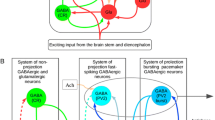Abstract
We recorded the neuronal activity of the medial region of the septum (MS-DB) intracellularly in guinea-pig septal slices. Electrical stimulation of the diagonal band (DB) evoked a low-threshold initial period of inhibition in the cells (20–280 msec in various cells). When the intensity of the stimulation was increased, this inhibitory phase shortened gradually or in a step-wise fashion, remaining unaltered in a portion of the cells with brief (40–50 msec) inhibition. The duration of the inhibition stabilized within a range of 30–60 msec. Many cells with single-spike background activity switched to generating post-inhibitory bursts at various levels of stimulation by current. Cells of the MS-DB with background rhythmical bursts always responded by phase locking to the stimulus. As a result, 58% of all of the cells of the MS-DB generated relatively short-latency, synchronized bursts when the level of afferent inflow was increased.
Similar content being viewed by others
Literature cited
A. B. Belousov and E. S. Brazhnik, “The role of GABAergic regulation in the organization of spontaneous and evoked activity of septal neurons,” Zh. Vyssh. Nervn. Deyat.,38, No. 6, 1076–1084 (1988).
E. S. Brazhnik, O. S. Vinogradova, and A. M. Karanov, “Regulation of the theta-activity of the neurons of the septum by cortical and brain stem structures,” Zh. Vyssh. Nervn. Deyat.,34, No. 1, 71–80 (1984).
O. S. Vinogradova, S. D. Zhadina, and E. S. Brazhnik, “Analysis of the organization of the background activity of septal neurons of the guinea pigs in vitro,” Neurofiziologiya,19, No. 5, 586–595 (1987).
S. D. Zhadina and O. S. Vinogradova, “The action of acetylcholine, noradrenaline, and serotonin upon the neurons of the septum in vitro,” Zh. Vyssh. Nervn. Deyat.,32, No. 2, 319–326 (1982).
G. Alvarez de Toledo and J. López-Barneo, “Tonic basis of the differential neuronal activity of guinea pig septal nucleus studied in vitro,” J. Physiol. (Engl.),396, 399–415 (1988).
P. Andersen, H. B. Bland, T. Myhrer, and P. A. Schwartzkroin, “Septo-hippocampal pathway necessary for dentate theta production,” Brain Res.165, No. 1, 13–22 (1979).
B. G. Border, R. J. Kosinski, S. A. Azizi, and G. A. Mihailoff, “Certain basilar pontine afferent systems are GABAergic: combined HRP and immunocytochemical studies in the rat,” Brain Res. Bull.,17, No. 2, 169–179 (1986).
D. R. Bradey and J. E. Vaughn, “A comparison of the localization of choline acetyltransferase and glutamate decarboxylase immunoreactivity in rat cerebral cortex,” Neuroscience,24, No. 3, 1009–1026 (1988).
H. R. Brashear, L. Zaborszky, and L. Heimer, “Distribution of GABAergic and cholinergic neurons in the rat diagonal band,” Neuroscience,17, No. 2, 439–448 (1986).
E. S. Brazhnik and O. S. Vinogradova, “Control of the neuronal rhythmic bursts in the septal pacemaker of theta-rhvthm: effects of anaesthetic and anticholinergic drugs,” Brain Res.,380, No. 1, 94–106 (1986).
P. Dutar, J. Lamour, and A. Jobert, “Septo-hippocampal neurons in the rat, an in vivo intracellular study,” Brain Res.,340, No. 1, 135–142 (1985).
R. S. Fisher, N. A. Buchwald, C. D. Hull, and M. S. Levine, “GABAergic basal forebrain neurons project to the neocortex: the localization of GAD and ChAT in feline corticopetal nucleus,” J. Comp. Neurol.,272, No. 4, 489–502 (1988).
L. L. Iversen, “Chemical signalling in the nervous system,” Progr. Brain Res.,68, 15–21 (1986).
C. Kohler and V. Chan Palay, “Distribution of GABA-containing neurons and terminals in the septal area: an immunohistochemical study using antibodies to glutamic acid decarboxylase,” Anat. Embryol.,167, No. 1, 53–66 (1983).
T. Kosaka, M. Tauchi, and J. L. Dahl, “Cholinergic neurons containing GABA-like and/or glutamic acid decarboxylase-like immunoreactivities in various brain regions of the rat,” Exp. Brain Res.,70, No. 3, 605–617 (1988).
Y. Lamour, P. Dutar, and A. Jobert, “Septo-hippocampal and other medial septum-diagonal band neurons: electrophysiological and pharmacological properties,” Brain Res.,309, No. 2, 227–239 (1984).
B. Onteiniente, H. Tago, H. Kimura, and T. Maeda, “Distribution of GABA-immunoreactive neurons in the septal region of the rat brain,” J. Comp. Neurol.,248, No. 3, 422–430 (1986).
H. Petsche, C. Stumpf, and G. Gogolak, “The significance of the rabbit's septum as a relay station between the midbrain and the hippocampus,” EEG Clin. Neurophysiol.,14, No. 2, 202–211 (1962).
H. Petsche, G. Gogolak, and P. A. van Zwieten, “Rhythmicity of septal cell discharges at various levels of reticular excitation,” EEG Clin. Neurophysiol.,19, No. 1, 25–33 (1965).
J. N. P. Rawlins, J. Feldon, and J. A. Gray, “Septo-hippocampal connections and the hippocampal theta rhythm,” Exp. Brain Res.,37, No. 1, 49–63 (1979).
K. Satoh and H. C. Fibeger, “Cholinergic neurons of the laterodorsal tegmental nucleus: efferent and afferent connections,” J. Comp. Neurol.,253, No. 3, 277–302 (1986).
M. Segal, “Properties of rat medial septal neurones recorded in vitro,” J. Physiol. (Engl.),379, 309–330 (1986).
R. P. Vertes, “Brainstem modulation of the hippocampus. Anatomy, physiology, and significance,” in: The Hippocampus, Vol. 4, Plenum Press, N. Y. (1986), pp. 41–75.
O. S. Vinogradova, E. S. Brazhnik, A. M. Karanov, and S. D. Zhadina, “Analysis of neuronal activity in rabbit's septum with various conditions of deafferentation,” Brain Res.,187, No. 2, 354–368 (1980).
N. J. Woolf and L. L. Butcher, “Cholinergic systems in the rat brain: III. Projections from the pontomesencephalic tegmentum to the thalamus, tectum, basal ganglia, and basal forebrain,” Brain Res. Bull.,16, No. 5, 603–637 (1986).
Author information
Authors and Affiliations
Additional information
Translated from Zhurnal Vysshei Nervnoi Deyatel'nosti imeni I. P. Pavlova, Vol. 39, No. 5, pp. 924–934, September–October, 1989.
Rights and permissions
About this article
Cite this article
Belousov, A.B., Vinogradova, O.S. Modelling the regulation of theta-rhythm by increasing afferent inflow in septal slices. Neurosci Behav Physiol 20, 437–445 (1990). https://doi.org/10.1007/BF01192348
Received:
Revised:
Issue Date:
DOI: https://doi.org/10.1007/BF01192348




